N-SF11 Plano-Concave Lenses, AR Coated for 350 - 700 nm
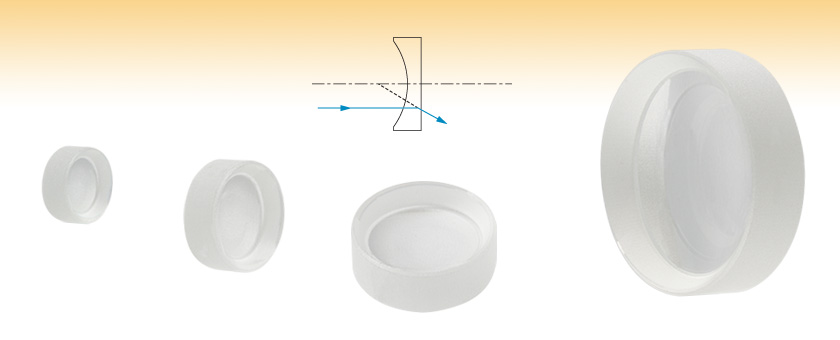
- AR Coated for 350 - 700 nm
- Used to Diverge Collimated Beams
- Excellent Chemical Resistance
LC2969-A
(Ø6 mm)
LC2067-A
(Ø9 mm)
LC2265-A
(Ø1/2")
LC2679-A
(Ø1")

Please Wait
| Common Specifications | |
|---|---|
| Lens Shape | Plano / Concave |
| Substrate Material | N-SF11a |
| AR Coating Rangeb | 350 - 700 nm |
| Diameters Available | 6 mm, 9 mm, 1/2", or 1" |
| Diameter Tolerance | +0.00/-0.10 mm |
| Thickness Tolerance | ±0.1 mm |
| Focal Length Tolerance | ±1% |
| Design Wavelength | 587.6 nm |
| Index of Refraction @ 633 nm | 1.778 |
| Abbe Number | Vd = 25.76 |
| Surface Quality | 40-20 Scratch-Dig |
| Surface Flatness (Plano Side) | λ/2 |
| Spherical Surface Power (Concave Side)c | 3λ/2 |
| Surface Irregularity (Peak to Valley) | λ/4 |
| Centration | ≤3 arcmin |
| Clear Aperture | >90% of Diameter |
| Focal Length Tolerance | ±1% |
| Click on the red Document icon next to the item numbers below to access the Zemax file download. Our entire Zemax Catalog is also available. |
Features
- Material: N-SF11
- Broadband Antireflection Coating for the 350 - 700 nm Range
- Choose from 4 Diameters: 6 mm, 9 mm, 1/2", or 1"
- Offers Better Chemical Resistance than N-BK7
These Plano-Concave lenses, which are fabricated from N-SF11 glass, have a broadband antireflection coating for the 350 - 700 nm range deposited on both faces. The AR coating greatly reduces the 4% losses per surface incurred when using an uncoated lens (see the Graphs tab for details).
N-SF11 glass, a RoHS compliant version of SF11, is most commonly used in harsh environments since it is inert to biological degradation and resistant to naturally encountered chemicals, alkalis, and acids. With an uncoated wavelength range of 420 nm - 2.3 μm, N-SF11 also offers a usage range that is slightly shifted to the red compared to N-BK7, which is our RoHS-compliant BK7 glass and has an uncoated wavelength range of 350 nm - 2.0 μm. Since N-SF11 glass has a lower Abbe Number than N-BK7 glass (25.76 compared to 64.17), it is associated with more dispersion.
Like all plano-concave lenses, these lenses have negative focal lengths and can be used to diverge collimated beams. In this case, the curved surface of the lens should face the source to minimize spherical aberration. In addition, they can be employed to offset the effects of spherical aberration caused by other lenses in an optical system.
| Plano-Concave Lens Selection Guide | |||||
|---|---|---|---|---|---|
| Unmounted N-BK7 |
|
||||
| Mounted N-BK7 |
|
||||
| N-SF11 |
|
||||
| UV Fused Silica |
|
||||
| CaF2 |
|
||||
| ZnSe |
|
||||
Custom coatings are also available. Please contact Tech Support for a quote.
| Quick Links to Other Spherical Singlets | ||||||
|---|---|---|---|---|---|---|
| Plano-Convex | Bi-Convex | Best Form | Plano-Concave | Bi-Concave | Positive Meniscus | Negative Meniscus |
Below is the measured transmission for a 10 mm thick uncoated sample of N-SF11 using normal incident light. Each lens can be purchased uncoated or with our -A (350-700 nm), -B (650 - 1050 nm), or -C (1050 - 1700 nm) antireflection coating.
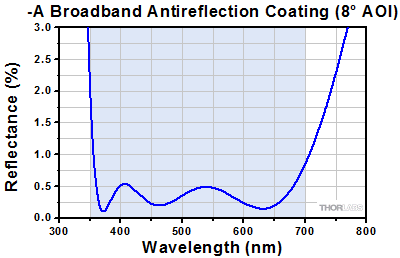
Click to Enlarge
Click Here for Raw Data
The blue shaded region indicates the specified 350 - 700 nm wavelength range for optimum performance.
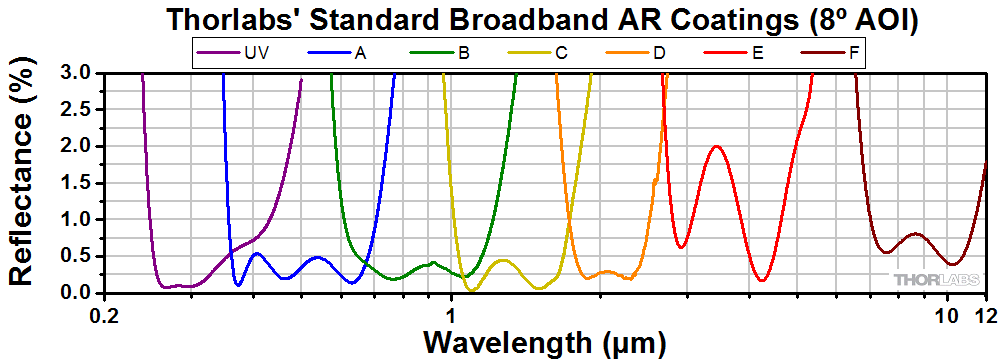
| Recommended Mounting Options for Thorlabs Lenses | ||
|---|---|---|
| Item # | Mounts for Ø2 mm to Ø10 mm Optics | |
| Imperial | Metric | |
| (Various) | Fixed Lens Mounts and Mini-Series Fixed Lens Mounts for Small Optics, Ø5 mm to Ø10 mm | |
| (Various) | Small Optic Adapters for Use with Standard Fixed Lens Mounts, Ø2 mm to Ø10 mm | |
| Item # | Mounts for Ø1/2" (Ø12.7 mm) Optics | |
| Imperial | Metric | |
| LMR05 | LMR05/M | Fixed Lens Mount for Ø1/2" Optics |
| MLH05 | MLH05/M | Mini-Series Fixed Lens Mount for Ø1/2" Optics |
| LM05XY | LM05XY/M | Translating Lens Mount for Ø1/2" Optics |
| SCP05 | 16 mm Cage System, XY Translation Mount for Ø1/2" Optics | |
| (Various) | Ø1/2" Lens Tubes, Optional SM05RRC Retaining Ring for High-Curvature Lenses (See Below) |
|
| Item # | Mounts for Ø1" (Ø25.4 mm) Optics | |
| Imperial | Metric | |
| LMR1 | LMR1/M | Fixed Lens Mount for Ø1" Optics |
| LM1XY | LM1XY/M | Translating Lens Mount for Ø1" Optics |
| ST1XY-S | ST1XY-S/M | Translating Lens Mount with Micrometer Drives (Other Drives Available) |
| CXY1A | 30 mm Cage System, XY Translation Mount for Ø1" Optics | |
| (Various) | Ø1" Lens Tubes, Optional SM1RRC Retaining Ring for High-Curvature Lenses (See Below) |
|
| Item # | Mount for Ø1.5" Optics | |
| Imperial | Metric | |
| LMR1.5 | LMR1.5/M | Fixed Lens Mount for Ø1.5" Optics |
| (Various) | Ø1.5" Lens Tubes, Optional SM1.5RR Retaining Ring for Ø1.5" Lens Tubes and Mounts |
|
| Item # | Mounts for Ø2" (Ø50.8 mm) Optics | |
| Imperial | Metric | |
| LMR2 | LMR2/M | Fixed Lens Mount for Ø2" Optics |
| LM2XY | LM2XY/M | Translating Lens Mount for Ø2" Optics |
| CXY2 | 60 mm Cage System, XY Translation Mount for Ø2" Optics |
|
| (Various) | Ø2" Lens Tubes, Optional SM2RRC Retaining Ring for High-Curvature Lenses (See Below) |
|
| Item # | Adjustable Optic Mounts | |
| Imperial | Metric | |
| LH1 | LH1/M | Adjustable Mount for Ø0.28" (Ø7.1 mm) to Ø1.80" (Ø45.7 mm) Optics |
| LH2 | LH2/M | Adjustable Mount for Ø0.77" (Ø19.6 mm) to Ø2.28" (Ø57.9 mm) Optics |
| VG100 | VG100/M | Adjustable Clamp for Ø0.5" (Ø13 mm) to Ø3.5" (Ø89 mm) Optics |
| SCL03 | SCL03/M | Self-Centering Mount for Ø0.15" (Ø3.8 mm) to Ø1.77" (Ø45.0 mm) Optics |
| SCL04 | SCL04/M | Self-Centering Mount for Ø0.15" (Ø3.8 mm) to Ø3.00" (Ø76.2 mm) Optics |
| LH160C | LH160C/M | Adjustable Mount for 60 mm Cage Systems, Ø0.50" (Ø13 mm) to Ø2.00" (Ø50.8 mm) Optics |
| SCL60CA | SCL60C/M | Self-Centering Mount for 60 mm Cage Systems, Ø0.15" (Ø3.8 mm) to Ø1.77" (Ø45.0 mm) Optics |
Mounting High-Curvature Optics
Thorlabs' retaining rings are used to secure unmounted optics within lens tubes or optic mounts. These rings are secured in position using a compatible spanner wrench. For flat or low-curvature optics, standard retaining rings manufactured from anodized aluminum are available from Ø5 mm to Ø4". For high-curvature optics, extra-thick retaining rings are available in Ø1/2", Ø1", and Ø2" sizes.
Extra-thick retaining rings offer several features that aid in mounting high-curvature optics such as aspheric lenses, short-focal-length plano-convex lenses, and condenser lenses. As shown in the animation to the right, the guide flange of the spanner wrench will collide with the surface of high-curvature lenses when using a standard retaining ring, potentially scratching the optic. This contact also creates a gap between the spanner wrench and retaining ring, preventing the ring from tightening correctly. Extra-thick retaining rings provide the necessary clearance for the spanner wrench to secure the lens without coming into contact with the optic surface.
| Posted Comments: | |
| No Comments Posted |
 Products Home
Products Home







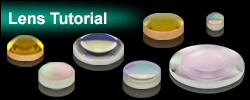

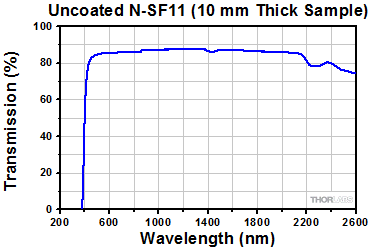
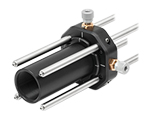
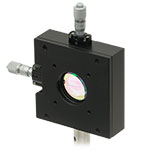
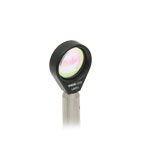


 N-SF11, -A Coated
N-SF11, -A Coated